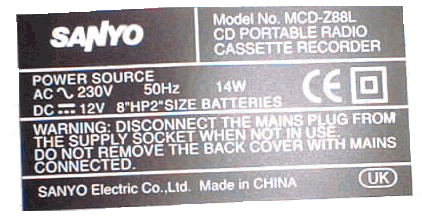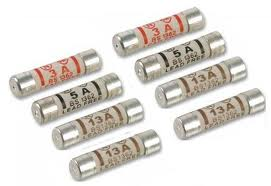Fuses
The fuse you fit in a plug should always be the same as the one recommended by the manufacturer of the appliance. A simple calculation can find out the most suitable fuse. P = IVfor domestic fuses V = 230V (UK mains voltage) P (the maximum power of the appliance) is marked on the appliance casing in watts
rearranging the equation we have : I = P/V so it is easy to calculate the maximum current that the appliance is designed to have flowing through it. A fuse is a safety device. It protects an electrical circuit from the effect of excessive current. It is basically a strip of metal that will melt when the current passing through it exceeds a certain value. This creates a gap in the circuit and thereby stops current flow. For the Sanyo CD Portable Cassette Recorder we can see that the power rating is 14W I = 14/230 = 0.061A It would therefore need a very low value fuse in the plug.
The 1A fuse would be the only appropriate one for this situation, but is really would not protect the circuitry very much! Fuses are designed so that the casing:
Fuses are produced
If a fault in an electrical circuit or an appliance causes too great a current to flow (e.g. when a short circuit occurs), the circuit is switched off by a fuse or a circuit breaker (you need to be able to explain how each of these works!). The fuse should be chosen to have a value higher than, but as close as possible to, the current through the appliance when it is working normally. When the current through a fuse wire exceeds the current rating of the fuse the wire becomes hot and will (eventually) melt breaking the circuit and switching off the current. The fuse is therefore not as quick acting as the circuit breaker. Many appliances
are 'fused' in the circuitry and also in the plug. This happens when
there is delicate circuitry that would be expensive to replace if it
was 'overloaded' and 'burnt out'. Very small value fuses can be incorporated
in this way. The CD player in the above example would have such a fuse within the case. Simple appliances will just be protected by a fuse in the
plug. Power Ratings of Common Appliances The more current that has to flow through an appliance the greater its power rating. Motors and heaters need large currents to operate. The more powerful these components of an appliance need to be, the larger the power rating will be and the larger the fuse value will need to be. This is the link between power rating and function. The homework activity instructions below help you to verify this. |
Follow me...
|


 Most plugs have 13A written on them. This means that they are suitable for being fitted with a fuse of up to 13A. It does not mean you have to fit them with a 13A fuse!
Most plugs have 13A written on them. This means that they are suitable for being fitted with a fuse of up to 13A. It does not mean you have to fit them with a 13A fuse!
 The common fuse values are 1A, 3A, 5A and 13A.
The common fuse values are 1A, 3A, 5A and 13A. 


